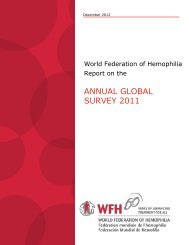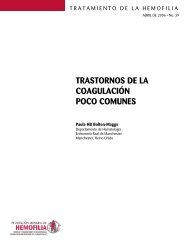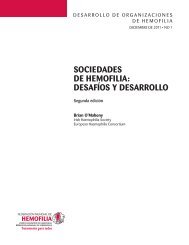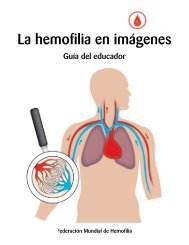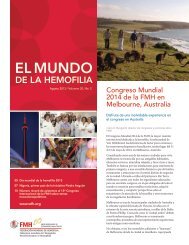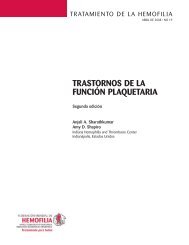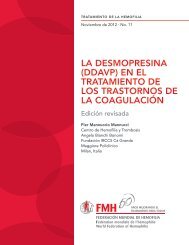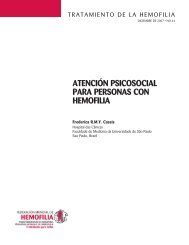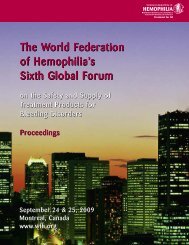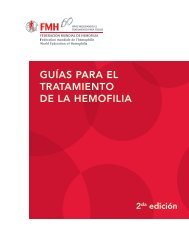Guide for the Assessment of Clotting Factor Concentrates
Guide for the Assessment of Clotting Factor Concentrates
Guide for the Assessment of Clotting Factor Concentrates
You also want an ePaper? Increase the reach of your titles
YUMPU automatically turns print PDFs into web optimized ePapers that Google loves.
Inventory holdInventory hold is <strong>the</strong> holding <strong>of</strong> plasma in (frozen) storage be<strong>for</strong>e it is processed into concentrates. Aplasma donation is held until testing <strong>of</strong> <strong>the</strong> donor ensures that <strong>the</strong> donation was not collected while<strong>the</strong> donor was in <strong>the</strong> window period <strong>of</strong> disease. The use <strong>of</strong> inventory hold pending qualification <strong>of</strong> plasmadonors fur<strong>the</strong>r enhances safety and is an attractive, although not mandatory, feature. This measure isgenerally only possible <strong>for</strong> source plasma, as apheresis donors can donate more frequently which mayresult in more donations during <strong>the</strong> infectious window period. The particular features <strong>of</strong> an inventoryhold vary across <strong>the</strong> organizations which practice it. It is most effective when donations which are notre-tested are not used, whe<strong>the</strong>r <strong>the</strong> donor returns or not. This is not always <strong>the</strong> case, and <strong>the</strong> particularfeatures <strong>of</strong> a plasma supplier’s inventory hold should be kept in mind in assessing <strong>the</strong> relative safetymerits <strong>of</strong> paid and unpaid plasma sources.Ensuring <strong>the</strong> safety <strong>of</strong> raw materialsDonor selection procedures that exclude high-risk donors, combined with serological screening <strong>of</strong> plasmadonations are <strong>the</strong> mainstay <strong>of</strong> ensuring safe raw material <strong>for</strong> <strong>the</strong> fractionation process. The safety <strong>of</strong><strong>the</strong> raw material can only be ensured by <strong>the</strong> fractionator through <strong>the</strong> use <strong>of</strong> suppliers that excludehigh-risk donors and use good quality viral screening tests. Fur<strong>the</strong>r guidance on how regulatoryauthorities can make certain <strong>of</strong> <strong>the</strong> safety <strong>of</strong> raw material used <strong>for</strong> blood products is provided inSections 2, 3, and 4. Some fractionators may purchase plasma from <strong>the</strong> open or so-called “spot” plasmamarket, ra<strong>the</strong>r than obtain it from <strong>the</strong>ir own centres or from centres subscribing to <strong>the</strong>ir own standards.The use <strong>of</strong> such “spot” plasma will not be subject to <strong>the</strong> same level <strong>of</strong> safety and regulatory control as<strong>the</strong> use plasma from well-accredited centres, and authorities should not consider using products manufacturedfrom this type <strong>of</strong> plasma.Viral reduction processesThere are two types <strong>of</strong> viral reduction processes: inactivation (viral kill) and removal <strong>of</strong> virus throughpurification <strong>of</strong> protein. Viral elimination procedures in <strong>the</strong> manufacturing process have had <strong>the</strong> greatestimpact on enhancing <strong>the</strong> safety <strong>of</strong> hemophilia treatment products. While all <strong>the</strong> components <strong>of</strong> <strong>the</strong>blood safety chain described in this guide are required <strong>for</strong> product safety, manufacturing processes canhave an especially significant role. For example, solvent-detergent treatment made pooled hemophiliatreatment products safe from hepatitis C be<strong>for</strong>e <strong>the</strong> introduction <strong>of</strong> testing <strong>for</strong> <strong>the</strong> virus increased <strong>the</strong>safety <strong>of</strong> normal blood transfusion and single-donor cryoprecipitate from HCV transmission. Authoritiestasked with assessing which measures are essential <strong>for</strong> ensuring safe products – as opposed to thosewhich, while enhancing safety, are not essential – need to keep in mind <strong>the</strong> features <strong>of</strong> plasma derivatives,such as hemophilia products, relative to <strong>the</strong> hospital products <strong>of</strong> mainstream blood banking.While donor selection and screening <strong>of</strong> donations, combined with appropriate NAT testing (andinventory hold where it can be achieved), have significantly reduced <strong>the</strong> risk <strong>of</strong> blood-borne virusesentering <strong>the</strong> fractionation pool, we must presume that any plasma pool <strong>for</strong> fractionation may containlevels <strong>of</strong> virus capable <strong>of</strong> transmitting infection. The inclusion, in <strong>the</strong> fractionation process, <strong>of</strong> one ormore steps with validated capability to inactivate and/or remove relevant viruses, primarilyenveloped viruses (HIV, HBV, and HCV), results in plasma products that are essentially free from risk<strong>of</strong> <strong>the</strong>se viruses. However, current inactivation and removal processes are less effective <strong>for</strong> nonenvelopedviruses (mainly HAV and parvovirus B19, and <strong>the</strong> concern can be extended to “unknown”viruses and infectious agents also).6 <strong>Guide</strong> <strong>for</strong> <strong>the</strong> <strong>Assessment</strong> <strong>of</strong> <strong>Clotting</strong> <strong>Factor</strong> <strong>Concentrates</strong>



